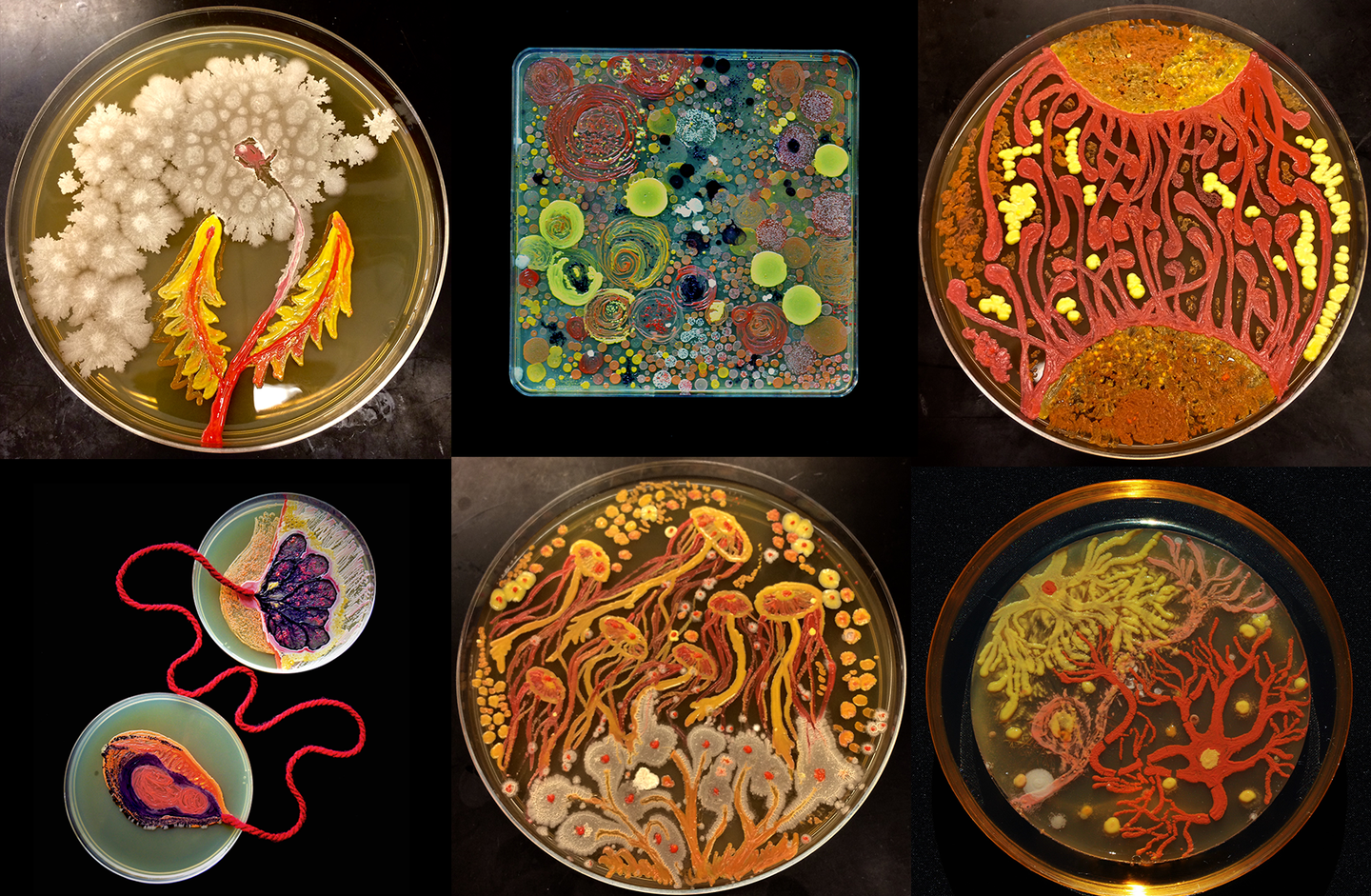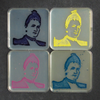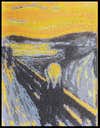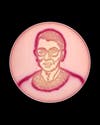These intricate ‘living’ paintings are teeming with microscopic organisms
Scientists and artists alike are using genetic engineering and imagination to grow microbes into intricate, artistic patterns.

When artist Maria Peñil Cobo has a new idea for a painting, she starts by choosing a palette of bacteria. Perhaps Serratia marcescens, which blooms brilliant cherry red, or Streptomyces coelicolor that grows sky blue. Her canvas is a Petri dish full of a jelly-like substance called agar, which the brightly colored bacteria love to eat. She carefully dips a flame-sterilized wire—her paintbrush—in the Serratia and draws an invisible design on her canvas. In a few days, the bacteria will multiply into the shape of a jellyfish that can be seen with the naked eye.
Tucked away in labs, scientists and artists like Peñil Cobo have been culturing creations of art on agar for the American Society of Microbiology (ASM) annual microbial art contest. Since the competition began in 2015, winners from around the world have created images of everything from camels to dandelions—all made from microbes. This year’s winners, announced November 30, painted portraits of their favorite microbiologists, including Rosalind Franklin and Odo Bujwid.
The competition is open to everyone—scientists, artists, non-artists, even kids. Community labs offer bioengineered microbes for public art workshops, while at-home kits allow anyone to brew agar and grow their own colorful bacteria. Most microbes don’t cause disease in humans, but it’s a good idea for beginners to start with these options where the strains have been engineered or carefully selected for safety.

In some ways, microbial art is simple, says Mehmet Berkmen, a bacterial geneticist at New England Biolabs in Ipswich, Massachusetts, who won ASM’s inaugural contest with artist Peñil Cobo in 2015. Microbiologists have long known that bacteria come in a diversity of shapes and shades, and scientist-artists have been harnessing colorful bacteria to create works of art since at least the 1920s. Creating microbial masterpieces is not much different from painting. But because the hues are living cells, it’s hard to predict exactly what they’ll do as they grow. If you apply a red-colored bacteria beside a white-colored one, for instance, the white bacteria could produce chemicals that prevent the other bacteria from making its red color, Berkmen says. “So, you not only need to know them individually, but [how they interact] as a group.”
To circumvent this problem, some scientist-artists genetically engineer the same type of microbes in different colors. It’s a trick that requires borrowing genes from other organisms that are good at making certain colors—like carrots, which appear orange because of small molecules, or pigments, called beta-carotene. By transferring beta-carotene genes from a carrot to a microbe, a scientist can coax the microorganism to produce an orange color.
Microbes are like pandas: beautiful and fluffy.
— Mehmet Berkmen, bacterial geneticist at New England Biolabs
“We’re just shamelessly plagiarizing what exists in nature,” says Sudarshan Pinglay, a synthetic biologist at New York University Langone Health.
The advantage of “plagiarizing” genes is that it lends the artist more control over their finicky living paint, says Pinglay. Microbes can also be specifically altered so they are safe for humans—a big reason why citizen scientist-artists might opt for manipulated bacteria over species cultured from the wild. The lab-designed microorganisms better ensures safety. They also allow for very precise replications of designs, like Pinglay’s lab’s pixelated reproduction of The Scream, made entirely of manipulated yeast.

Other scientist-artists, like Peñil Cobo and Berkmen, prefer to stick to the original hues microbes produce in nature. On top of anticipating interactions between species, using different strains is challenging because they can be picky about their living conditions, favoring different temperatures and growing at different rates. So you might need to paint an orange bacteria a few days before the purple one if the orange type grows much slower. Or—if you want to embrace the unexpected—you could grow them all at once and see what happens.
“There are no rules, basically,” says Berkmen. But to create good art, as with any other medium, “you have to be very familiar with it…. And that only comes with experience.”

After a decade of mastering different species for her artwork, despite having no background in microbiology, Peñil Cobo knows more about the critters’ preferences and interactions than even Berkmen does. He says her knowledge could help other microbial artists and scientists in the future.
[Related: Classic Mexican art stood the test of time with the help of this secret ingredient]
Exposing the beauty of microbes has led to useful scientific application. For instance, Berkmen wanted to film time-lapse videos of the growing microbial art, but it was hard to do without exposing the agar to air, which dries the jelly-like medium out quickly. Without this essential food and water, the bacteria will stop growing and eventually die. So, to solve the problem, Berkmen and his team built a custom chamber and started adding components to keep the agar well-hydrated. The imaging technology allowed him to see some Bacillus species change color from white to orange after three weeks—an observation never recorded before because no one had ever watched the bacteria grow over such a long period of time. He later detailed the design of the apparatus and process in a study published in the Journal of Bacteriology.

“It was a scientific publication that began with trying to show the beauty of bacteria,” he says, adding that he hopes the device will continue to help uncover unseen microbial behavior.
Berkmen sees microbial artwork as a valuable tool for patching up bacteria’s bad reputation. In a world with millions of microbe species—some have estimated a trillion—only a small percentage are known to cause disease in humans. These intricate paintings can help introduce people to the beneficial kinds.
Microbes are “like pandas: beautiful and fluffy,” Berkmen says. “It’s difficult to convey that using conventional scientific communication, [but] art is a universal language.”
Images of the microbial art are courtesy of the artists and the American Society of Microbiology. View more artworks on ASM’s contest page.
Correction (December 12, 2022): This story has updated to correct a few misspellings of Mehmet Berkmen’s name. We regret the error.